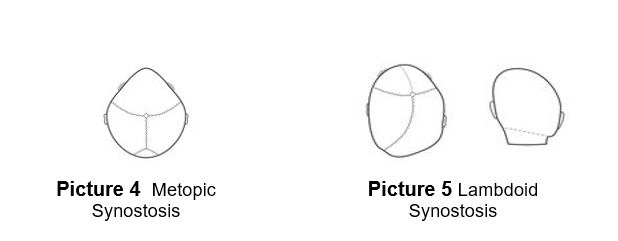Craniosynostosis

Craniosynostosis is a medical condition where one or more of the openings (known as sutures) between skull bones have closed too soon. This will affect the shape of the skull. It can also mean that over time brain growth may be restricted. This could result in increased pressure on the brain. In many cases, the cause of Craniosynostosis is not known.
Signs and Symptoms
An abnormal-appearing head shape is the first outward sign of this condition. As the skull grows, specific abnormalities may become more visible.
Types of Craniosynostosis
These are the 5 identified types of Craniosynostosis (Pictures 1 – 5).
- Sagittal Synostosis (SAJ i tul SI no STO sis) is the most common type of Craniosynostosis (Picture 1). The head appears long and narrow.
- Unilateral Coronal (uni LAT er al ker O nul) Synostosis makes the position of the eyes and eyebrows look offset (Picture 2).
- Bilateral Coronal (bi LAT er al ker O nul) Synostosis makes the forehead appear flattened, and the head tall (Picture 3).
- Metopic (meh TOP ik) Synostosis makes the child’s forehead appear pointed. The eyes look closer together (Picture 4).
- Lambdoid (LAM doid) Synostosis is the least common type of this condition (Picture 5). The back of the skull is flattened. It can look like the child lies with their head turned the same way all the time. It must be differentiated from positional plagiocephaly.


Diagnosis
A diagnosis is made first by visual examination of the head shape. It is confirmed by a low-dose CT scan. This kind of quick CT image uses very little radiation.
Treatment
When craniosynostosis is confirmed, surgery is typically recommended. The surgical goals are to correct the head shape, prevent brain growth restriction and reduce the risk of pressure in the head over time. Based on your child’s diagnosis and age there may be several treatment options. Your surgeons will discuss the best option for your child.
Follow-up Appointments
You can expect for your child to have regular follow-up appointments with your child’s neurosurgeon and plastic surgeon until their late adolescence.
Write down all your questions as you think of them. Bring this list with you when you see the doctor. Be sure to call your child’s doctor if you cannot keep the appointment.
HH-I-464 © 2020, Nationwide Children’s Hospital
